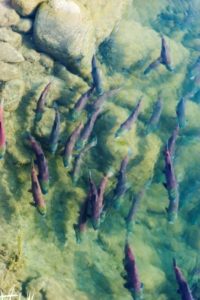22
Jan
Take Action: Tell EPA to Ban Three Pesticides that Threaten Endangered Species
(Beyond Pesticides, January 22, 2018) The organophosphate pesticides chlorpyrifos, malathion, and diazinon are likely to  jeopardize the continued existence of endangered species and adversely modify their critical habitats, according to the newly released report from the National Marine Fisheries Service (NMFS). By law, the Environmental Protection Agency (EPA) must not allow their use.
jeopardize the continued existence of endangered species and adversely modify their critical habitats, according to the newly released report from the National Marine Fisheries Service (NMFS). By law, the Environmental Protection Agency (EPA) must not allow their use.
Under Section 7 of the Endangered Species Act (ESA), any agency action requires a finding that the action “is not likely to jeopardize the continued existence of any endangered species or threatened species or result in the destruction or adverse modification of habitat.” The December 31, 2017 Biological Opinion from NMFS followed an ecological assessment that relied upon multiple lines of evidence to determine effects on species and their designated habitats.
These impacts include:
• “the direct and indirect toxicity of each chemical to aquatic taxa groups (e.g., fish, mammals, invertebrates);
• specific chemical characteristics of each pesticide (e.g., degradation rates, bioaccumulation rates, sorption affinities, etc.);
• expected environmental concentrations calculated for generic aquatic habitats
• authorized pesticide product labels;
• maps showing the spatial overlap of listed species’ habitats with pesticide use areas; and
• species’ temporal use of those lands and/or aquatic habitats on which each pesticide has permitted uses.”
The Biological Opinion finds, “[P]esticides containing chlorpyrifos are likely to jeopardize the continued existence of 38 of the 77 listed species, and adversely modify 37 of the 50 designated critical habitats.” For malathion, 38 of 77 listed species are likely to be jeopardized and 37 of the 50 designated critical habitats adversely modified. Likewise, diazinon likely jeopardizes 25 of 77 listed species and adversely modifies 18 of the 50 designated critical habitats. Species affected include salmon, steelhead, sturgeon, coral, and sea turtles, as well as orcas and seals that depend on salmon as a food source.
This Biological Opinion, which resulted from a lawsuit filed against EPA in 2014 for failure to comply with the ESA, is in line with the 2016 findings by EPA that chlorpyrifos and malathion are “likely to adversely affect” 97% of listed and candidate species, and diazinon “likely to adversely affect” 79% of endangered species under the ESA. Although EPA is required to consult with the Fish and Wildlife Service (FWS) and NMFS when registering a pesticide, the agencies have been sued over the years for disregarding this requirement and failing to ensure adequate protections for endangered species. A 2013 report from the National Academy of Sciences identified deficiencies and provided recommendations for all the agencies involved in pesticide consultations.
The three organophosphates are highly toxic to mammals, fish, and aquatic invertebrates, and are used widely in agriculture, as well as on forested lands, and even in mosquito spraying. According to NMFS, current application of these pesticides produces aquatic concentrations that are likely to harm aquatic species, as well as contaminate their designated critical habitats. Species and their prey residing in shallow aquatic habitats proximal to pesticide-use sites are expected to be at greatest risk. NMFS made several risk-reduction recommendations, including no-spray buffer zones of more than 300 meters alongside habitats, and removal of high-risk label uses.
According to Earthjustice, federal inaction against these pesticides puts at risk billions of dollars and thousands of jobs. Salmon and steelhead fishing in Oregon, Washington, Idaho, and Northern California is responsible for $1.25 billion in the regional economy, and supports more than 62,000 family wage jobs. But salmon populations have declined over the years due to damming activity, climate change, widespread habitat loss, and pesticide runoff. Scientists have found that, even at low levels, pesticides can cause the abnormal sexual development of salmon and impair their swimming ability, growth, development, behavior, and reproduction.
All unattributed positions and opinions in this piece are those of Beyond Pesticides.










